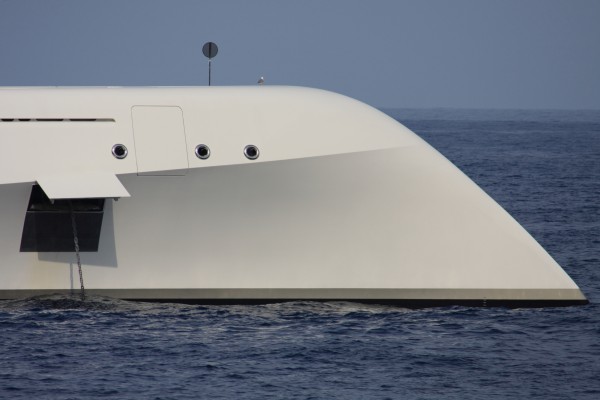Reverse bows – does form follow function?
Does form follow function with reverse bows? We talk to James Roy from BMT Nigel Gee to find out…
With an increasing number of reverse bow projects, what is it that makes them an attractive hull configuration? As the saying goes “form follows function,” but in this case, the benefits are so marginal that it could mean that a reverse bow is purely an aesthetical attribute rather than a functional one. The two primary aspects affected by the reverse bow would be an impact on resistance and an affect on seakeeping, but are these impacts significant enough to influence buying decisions?
While the reverse bow arrangement is nothing new to the maritime industry – having been utilised on military vessels for over a century – it appears that the design only materialised recently in the superyacht market, when Feadship’s 72.8m M/Y Predator was completed in 2008 and again with the delivery of M/Y A by Blohm + Voss in the same year.
“With a reverse bow you gain waterline length over a traditional raked bow, which is advantageous for resistance and powering,” says James Roy, yacht design director at BMT Nigel Gee. While this is an advantage, is it enough to sway buying decisions? “On a traditionally raked bow with a bulbous bow you can effectively achieve the same level of powering,” continues Roy. “So the reality is there is no significant advantage of a reverse raked bow from a powering perspective.” Here it appears that the more common raked bow can mimic the advantages of a reverse bow, so it’s the aesthetical values which appear to be the most appealing aspect in terms of power.
But there is also a question of seakeeping – does a reverse bow deal with large sea states with the same integrity as a conventional raked bow? “The reverse bow will have less added resistance in bigger sea states,” comments Roy. “Therefore a vessel can maintain a higher speed in a rough sea. However, it will be far wetter on deck than a reverse bow and the accelerations on a reverse bow will also be lower than on a raked bow for a given speed.”
Due to the variety of pros and cons when it comes to the reverse bow, it is difficult to determine whether the reverse bow holds an advantage over the conventional raked bow. It seems that the more prominent advantages of a reverse bow come with a multitude of compromises which would often defeat the purpose of choosing it primarily based on functionality.
“The reality is that choosing a reverse bow for application on a yacht is purely an aesthetic,” concludes Roy. “If one did want the technical advantages then you would go for a plumb bow, because with a reverse bow you loose a lot of deck area forward, and forward topside volume.” Both of these points are actually detrimental to the usable volume of a yacht, primarily affecting the crew accommodation to a further degree than with conventionally raked bows, which are already small.
Due to the fact that all the effects on the yachts performance are minimal, it’s safe to say that reverse bow projects are primarily focused on the way the yacht looks as opposed to how it functions. While there are advantages to the arrangement in large sea states, it’s unlikely that an owner would change their mind as a result.
Profile links
NEW: Sign up for SuperyachtNewsweek!
Get the latest weekly news, in-depth reports, intelligence, and strategic insights, delivered directly from The Superyacht Group's editors and market analysts.
Stay at the forefront of the superyacht industry with SuperyachtNewsweek
Click here to become part of The Superyacht Group community, and join us in our mission to make this industry accessible to all, and prosperous for the long-term. We are offering access to the superyacht industry’s most comprehensive and longstanding archive of business-critical information, as well as a comprehensive, real-time superyacht fleet database, for just £10 per month, because we are One Industry with One Mission. Sign up here.
NEW: Sign up for
SuperyachtNewsweek!
Get the latest weekly news, in-depth reports, intelligence, and strategic insights, delivered directly from The Superyacht Group's editors and market analysts.
Stay at the forefront of the superyacht industry with SuperyachtNewsweek




